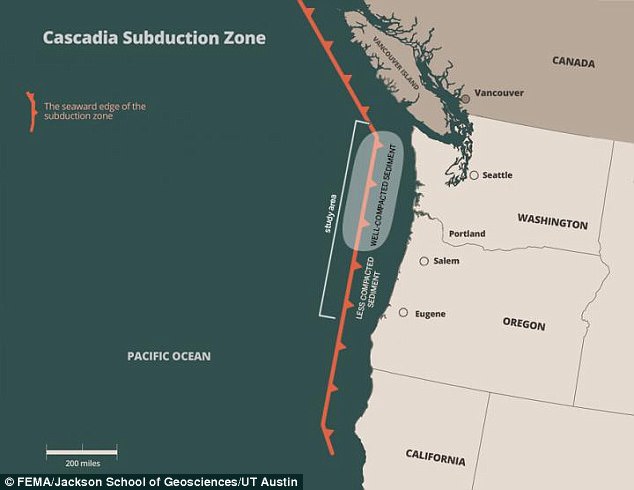Major Earth Changes - Fresh warnings over 'THE BIG ONE' as study finds seafloor sediments off the Pacific Northwest could unleash a MEGAQUAKE AND a TSUNAMI!

Researchers found that such a quake may be more likely to strike off the coast of Washington and northern Oregon than regions further south along the subduction zone. Seismic data and sediment samples found that sediments are tightly packed on the plate off the northern sites.
The threat of ‘The Big One’ has long loomed over the Pacific Northwest, where several major cities from Vancouver down to northern California are cradled by the 620-mile-long Cascadia Subduction Zone.
The geological record shows the area is due for a major earthquake, which would likely be followed by a massive tsunami.
Now, a new study has confirmed the region just off the coast of Washington has the ingredients for a megaquake.
The Cascadia Subduction Zone last experienced a large earthquake in the 1700s – and, it’s thought to generate a major event roughly every 200 to 530 years.
While it’s impossible to pinpoint the exact timing, experts have long warned the region could soon see another major quake.
In the study, led by a team at the University of Texas at Austin, researchers found that such a quake may be more likely to strike off the coast of Washington and northern Oregon than regions further south along the subduction zone.
Seismic data and sediment samples found that sediments are tightly packed on the plate off the northern sites.
There, little water sits in the pore spaces between the grains, leaving the plates more prone to the build-up of stress.
Under these conditions, the sediments are better able to stick together, and move together in the event of an earthquake – meaning they’re also able to move massive amounts of seawater.
‘We observed very compact sediments offshore of Washington and northern Oregon that could support earthquake rupture over a long distance and close to the trench, which increases both earthquake and tsunami hazards,’ said lead author Shuoshuo Han, a postdoctoral fellow at the University of Texas Institute for Geophysics (UTIG).
In a subduction zone, such as Cascadia, one tectonic plate is ‘diving’ beneath another.
The thick sediment layer on top of the subducting oceanic plate is scraped off as it moves, causing the sediments to pile onto the top plate in a wedge of material.
The rest travels down with the bottom plate, the researchers say.
Using nearly five-mile-long seismic streamers, the team observed up to four miles of sediment layers lying atop the Cascadia subduction zone.
While the sediments are tightly compacted off Washington and northern Oregon, they’re less compact off central Oregon.
With more pore space between the grains in this area, there would likely be much less stress accumulated there in the event of a rupture, meaning smaller earthquakes.
The higher stress region, however, has the makings for both a large earthquake and a subsequent tsunami.
‘That combination of both storing and more stress and the ability for it to propagate farther is important for both generating large earthquakes and for propagating to very shallow depths,’ said Nathan Bangs, a senior research scientist at UTIG and study co-author.
The ability of an offshore earthquake to propagate to shallow depths is what gives rise to huge tsunamis, such as the devastating wave that hit Tohoku, Japan in 2011 after a magnitude 9.0 earthquake.
According to co-author Demian Saffer, a professor at Penn State University, ‘The results are consistent with existing constraints on earthquake behaviour, offer an explanation for differences in structural style along the margin, and may provide clues about the propensity for shallow earthquake slip in different regions.’
SOURCE: http://www.dailymail.co.uk/sciencetech/article-5101461/Seafloor-sediments-ingredients-Big-One.html
An earthquake measuring near M5.0 (M4.7) has struck off the shores of Vancouver Island in the Pacific Northwest.
The earthquake forecast for this week called for upper M5.0-6.0 range activity nearby this location, therefore we are exactly 1 magnitude below what was warned to strike. This lesser movement is good news for the West coast of the United States, and for Southern California (which is located downstream from this new earthquake in Vancouver).
It is worthy to note that Vancouver Island was a topic of discussion in last nights (Nov. 20th) earthquake update video seen here.
This new seismic activity is on the very low end of what we were expecting, and is a result of the “slow slip” transferring across multiple states in the Pacific Northwest.
See the forecast warning for upper M5.0 activity here:
We are now expecting Southern California to be impacted by new seismic unrest over the next several days which could be as large as the earthquake in Vancouver, or a few points less. The M4.7 near Vancouver should drop to M4.5 or similar by the time the pressure reaches Southern California between Los Angeles, and San Diego.
The midwest United States (Oklahoma , Kansas, Colorado, Wyoming, Montana) needs to be on watch for a rapid increase in activity over the next several days topping out approximately 1 magnitude LESS than what struck near Vancouver. Upper M3.0 to lower M4.0 earthquake activity is possible near each states fracking operations, as well as near Yellowstone national park over this week.
As we have said in all of our past broadcasts, we want people to have a plan for 1 magnitude greater, in case we are wrong in our power estimates, or in case outside factors indicate an increase rapidly occurring.
Don’t be scared, be prepared . Make sure to have an earthquake plan.
SOURCE: https://www.dutchsinse.com/pacific-northwest-vancouver-struck-by-m5-0-m4-7-earthquake-as-expected/